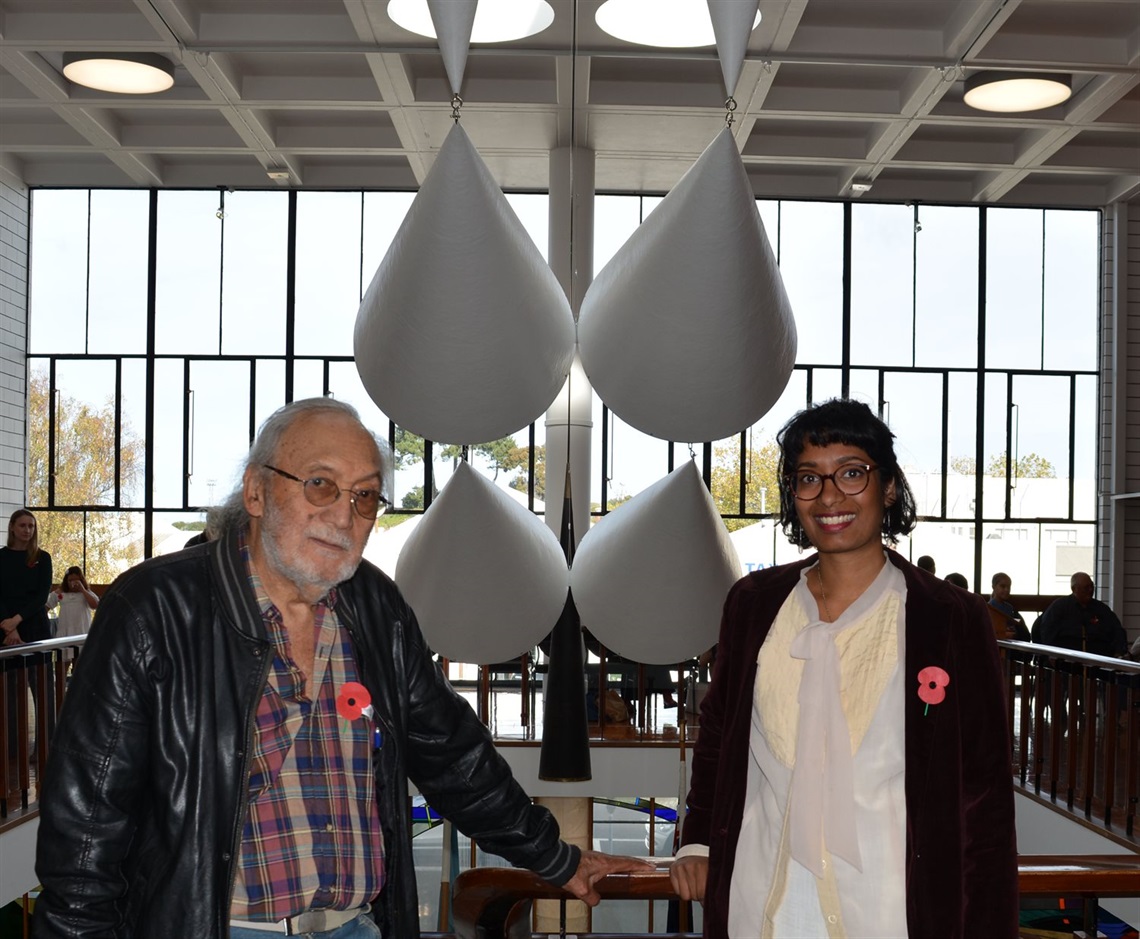Public sculpture back where it belongs
Published on 27 April 2021

Matt Pine with Anique Jayasinghe, Community Arts Coordinator at Whanganui & Partners and Chair of the Public Art Steering Group
Coinciding with Anzac weekend a private ceremony was held on Friday, 23 April to celebrate the reinstatement of Cone Piece, a memorial sculpture by acclaimed local artist Matt Pine who is of Te Āti Haunui-a-Pāpārangi, Te Āti Awa and Ngāti Tūwharetoa descent.
The artwork, originally commissioned by architect Bruce Dickson in 1985, had been in storage after being taken down from Whanganui’s War Memorial Centre for cleaning 18 years ago.
Anique Jayasinghe, Community Arts Coordinator at Whanganui & Partners, chairs the Public Art Steering Group. She says she feels a sense of satisfaction in seeing the artwork back up where it belongs.
“We’ve been unable to discover why the artwork was put into storage after it was taken down for cleaning 18 years ago.
“However, once the issue was raised with the Public Art Steering Group we swung into action and several council teams – including Archives, Facilities, and Venues and Events – worked with us to ensure it was returned to its rightful place.”
The council’s public art asset maintenance budget covered the cost of reinstallation, which was led by Excel Whanganui.
Anique Jayasinghe says the War Memorial Centre building feels complete with the artwork reinstated.
“Several other cities, including Wellington, Timaru and Dunedin, have public art by Matt Pine. However, ours is particularly special because it responds so wonderfully to the architecture of the building in which it is housed and because of its deep importance to the artist and this place.”
Cone Piece is made up of six cones that symbolically channel light from circular “light wells” on the War Memorial Centre’s ceiling down onto the Book of Remembrance below.
For Matt Pine, Cone Piece has an acute personal significance because the names of his father and other relatives are amongst the names of local people lost in World War II and recorded in the Book of Remembrance.
Matt Pine says before he was born his father, Corporal William – or “Wire” – Pine, of the 25th Battalion, was killed at the Battle of Sidi Rezegh in Libya in November 1941.
“Three-quarters were killed at the Battle of Sidi Rezegh because their weapons were obsolete against German weapons and armaments. My father was a Bren gun carrier driver and the vehicles were completely open at the top – they didn’t stand a chance.”
“Below my father’s name in the Book of Remembrance is my cousin, Flight Lieutenant Pohe, known as Johnny, who was killed in Germany in March 1944. He was a Halifax bomber pilot who ended up in the Stalag Luft III prisoner of war camp.
“Johnny lost his life in an escape attempt known as the Great Escape, where prisoners dug tunnels that came out in the open too far from the edge of the forest – when the prisoners were recaptured they were taken out into the trees in groups of five or six and shot.
“These events were something I’d always thought about.”
Over the years Matt Pine has held three separate memorial exhibitions at the Sarjeant Gallery Te Whare o Rehua – for his father, his cousin and also the uncle he was named after, Private Matthew Bailey, killed in Crete in May 1941.
At 79 years old Matt Pine is still a practising artist on the national circuit – his work features in Auckland Art Gallery’s current exhibition Toi Tū Toi Ora: Contemporary Māori Art and he has an exhibition scheduled for September at New Plymouth’s Govett-Brewster Art Gallery.
He will be familiar to some as the head of Te Wa; The Space Gallery which was an integral part of Whanganui’s creative sector in the 1990s.
Bill Milbank, curator of Milbank Gallery and former director of the Sarjeant Gallery, says Matt Pine is remarkably unique in New Zealand because his work has traditional Māori content but he arrives at it from a modernist perspective.
“Matt has a wonderful ability to interpret and read spaces with his work and Cone Piece is an excellent example of this.
“He is an important figure in the New Zealand art scene and it’s very exciting that he’s being discovered by a new generation of curators.”
Independent curator, Taarati Taiaroa, who is planning to work with Matt Pine towards an exhibition and publication surveying his artistic practice, says he is a pioneer of minimalist art in New Zealand.
“He is an important artist in New Zealand and Māori art histories – he is a leader in his field.
“Matt travelled to London in the early 1960s to further his arts education and that international influence can be seen in his work.
“While his work speaks an international art language, it is firmly grounded in the physical structures, construction techniques and forms that are unique to Aotearoa.
“His work was very radical for its time, and works he made in the 1970s and 1980s still resonate with people – they have a timeless quality as if they were made yesterday.”